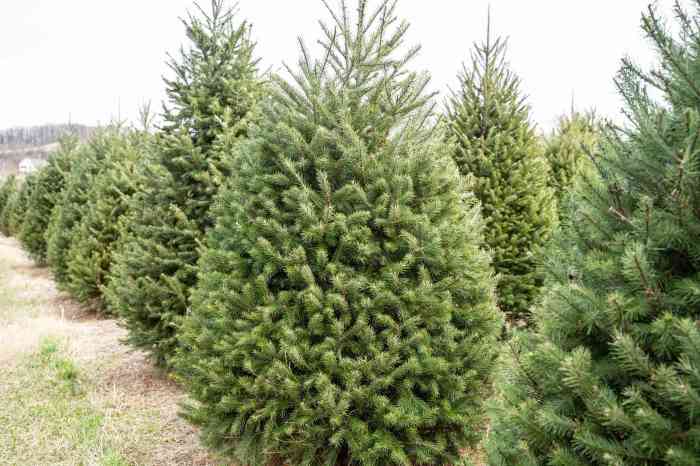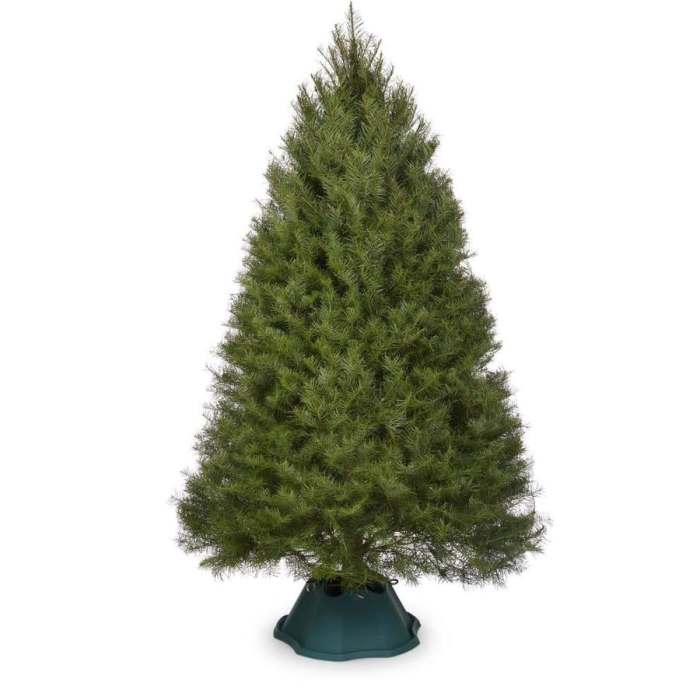Douglas Fir Characteristics for Planting: Douglas Fir Christmas Tree To Plant
Douglas fir christmas tree to plant – Planting a Douglas fir Christmas tree is a rewarding experience, offering the chance to grow your own festive centerpiece year after year. Understanding the tree’s needs ensures a healthy and thriving specimen. This section details the crucial factors for successful Douglas fir cultivation.
Ideal Soil Conditions for Douglas Fir
Douglas firs prefer well-drained, slightly acidic soil with a pH range between 5.5 and 6.5. Heavy clay soils can lead to poor drainage, resulting in root rot and stunted growth. Conversely, sandy soils may dry out too quickly, requiring more frequent watering. Ideally, a loamy soil—a mix of sand, silt, and clay—provides the best balance of drainage and water retention.
Adding organic matter like compost before planting significantly improves soil structure and fertility, creating a more hospitable environment for the young tree.
Sunlight Requirements for Douglas Fir Growth
Douglas firs are sun-loving trees. They require at least six hours of direct sunlight daily for optimal growth. Partial shade is tolerable, but prolonged periods in deep shade will result in weak, spindly growth and a less attractive tree. When choosing a planting location, consider the sun’s path throughout the day to ensure sufficient sunlight exposure.
Growth Rate of Douglas Fir Christmas Trees
The growth rate of a Douglas fir varies depending on factors such as soil conditions, sunlight, and overall climate. Under ideal conditions, a Douglas fir can grow 1 to 2 feet per year. However, in less favorable conditions, growth may be slower, possibly only a few inches annually. Consistent watering and fertilization during the growing season will encourage faster growth.
For example, a tree planted in rich, well-drained soil and receiving ample sunlight might reach 6-8 feet tall within five years.
Mature Size Comparison of Douglas Fir with Other Christmas Tree Species, Douglas fir christmas tree to plant
Douglas firs are known for their impressive mature size. Compared to other popular Christmas tree species, they are among the larger varieties. While a Fraser fir might reach a mature height of 30-40 feet, a Douglas fir can easily reach 50-70 feet or even taller, with a spread of 20-30 feet. This significant size difference should be considered when choosing a planting location, ensuring there’s ample space for the tree to mature without encroaching on buildings or power lines.
For example, a Norway Spruce, another common choice, has a similar mature height to the Douglas Fir but a slightly smaller spread.
Planting a Douglas Fir Seedling: A Step-by-Step Guide
Proper planting is crucial for the seedling’s survival and healthy growth. Here’s a step-by-step guide:
- Dig the hole: Dig a hole twice as wide and as deep as the root ball of the seedling. This allows for ample space for root expansion.
- Prepare the soil: Loosen the soil at the bottom of the hole to encourage root penetration. Amend the soil with compost if necessary.
- Position the seedling: Carefully place the seedling in the hole, ensuring the top of the root ball is level with the surrounding ground.
- Backfill the hole: Gently backfill the hole with soil, avoiding air pockets. Firm the soil around the base of the tree.
- Water thoroughly: Water deeply and slowly to settle the soil and encourage root contact.
- Mulch: Apply a 2-3 inch layer of organic mulch around the base of the tree, keeping it a few inches away from the trunk. This helps retain moisture and suppress weeds.
Selecting and Sourcing a Douglas Fir Sapling

Choosing the right Douglas fir sapling is crucial for a thriving Christmas tree (or future timber giant!). A healthy start ensures years of growth and enjoyment. Consider these factors when selecting your sapling to guarantee success.
Choosing a Healthy Douglas Fir Sapling
Inspecting a sapling before purchase is vital. Look for a tree with a straight, sturdy trunk free from noticeable bends or damage. The needles should be a vibrant, healthy green, not dull or yellowing, and should feel firm to the touch. Avoid saplings with any signs of disease, such as discoloration, wilting, or unusual growths. A well-developed root system (visible in bare-root saplings) is also a good indicator of health.
The overall appearance should suggest vigor and resilience. A slightly smaller but healthier sapling is preferable to a larger, weaker one.
Bare-Root Versus Container-Grown Saplings: A Comparison
The choice between bare-root and container-grown saplings involves trade-offs. Bare-root saplings are generally cheaper, but require more careful handling and planting to ensure survival. Their roots need to be kept moist during transportation and planting. Container-grown saplings, on the other hand, are more expensive but offer a higher survival rate because the root system is already established and protected.
Thinking of planting that lovely Douglas fir Christmas tree after the holidays? Before you dig, consider its mature size and root system; you’ll want to ensure it’s a suitable choice for your landscape. Choosing wisely is key, especially when considering proximity to your home, so check out this helpful guide on best trees to plant near house foundation to avoid future foundation issues.
Proper planning ensures your Douglas fir thrives for years to come, becoming a beautiful and lasting addition to your garden.
They are easier to transport and plant, minimizing transplant shock.
Potential Diseases and Pests and Their Prevention
Young Douglas firs can be susceptible to various diseases and pests. Root rot, caused by fungal pathogens in poorly drained soil, is a significant threat. Prevention involves choosing well-drained planting sites and avoiding overwatering. Other potential problems include needle diseases like Rhabdocline needle cast, which causes yellowing and premature needle drop. Proper spacing to ensure good air circulation can help prevent this.
Insects like aphids and spider mites can also infest young trees, causing stunted growth and needle damage. Regular inspection and timely application of appropriate insecticides (following label instructions carefully) can help manage these pests.
Price and Size Comparison of Douglas Fir Saplings
The price and size of Douglas fir saplings vary significantly depending on the vendor and the sapling’s age and size. The following table offers a sample comparison; actual prices may vary depending on location and season.
| Vendor | Size (Height in inches) | Price ($) | Notes |
|---|---|---|---|
| Local Nursery A | 12-18 | 15-20 | Container-grown |
| Online Retailer B | 12-18 | 12-18 | Bare-root, bulk discount available |
| Big Box Garden Center C | 24-36 | 30-40 | Container-grown, premium selection |
| Local Christmas Tree Farm D | 18-24 | 25-35 | Bare-root, may require pre-order |
Alternatives and Considerations

Choosing a Douglas fir is a fantastic option, but let’s explore other possibilities and weigh the pros and cons of a live tree versus the artificial alternative. This section will delve into alternative Christmas tree species, compare environmental impacts, offer resources for finding saplings, discuss the long-term commitment, and provide a handy checklist for success.
Alternative Christmas Tree Species
Beyond the majestic Douglas fir, several other evergreen species make excellent live Christmas trees. Noble firs, known for their strong branches and delightful fragrance, are a popular choice. Fraser firs, with their excellent needle retention and pleasing aroma, are another strong contender. Balsam firs, boasting a classic Christmas tree shape and beautiful fragrance, are also a viable option.
Each species offers slightly different characteristics in terms of needle retention, fragrance, and overall shape, allowing you to select a tree that best suits your preferences and growing conditions.
Environmental Impact Comparison: Live vs. Artificial Trees
The environmental impact of choosing between a live and an artificial Christmas tree is a complex issue. Artificial trees, while convenient, often have a significant carbon footprint due to their manufacturing process, involving petroleum-based plastics and often long-distance transportation. They are also not biodegradable and end up in landfills, contributing to waste. In contrast, a live Christmas tree, when properly sourced and planted, can sequester carbon dioxide, provide habitat for wildlife, and even contribute to soil health.
However, the transportation of live trees and the potential for deforestation if not sustainably sourced must be considered. Ultimately, a sustainably sourced and planted live tree offers a more environmentally friendly option over its lifespan, but careful consideration is needed during each step of the process.
Resources for Finding Douglas Fir Saplings
Locating Douglas fir saplings is easier than you might think! Local nurseries are an excellent starting point. Many nurseries specialize in native species and can offer advice on the best varieties for your region and soil conditions. Check online directories or search engines for “Christmas tree nurseries near me.” Additionally, some arboreta or botanical gardens may sell saplings, offering both expertise and sustainably sourced trees.
Contacting your local agricultural extension office is another valuable resource; they can often provide information on local nurseries and sustainable forestry practices.
Long-Term Commitment of Growing a Live Christmas Tree
Growing a live Christmas tree is a rewarding but long-term commitment. It requires patience and consistent care. The tree will need regular watering, especially during dry periods, and fertilization to ensure healthy growth. You’ll need to protect it from pests and diseases, potentially involving pruning and treatment. Over several years, the tree will grow significantly, requiring adequate space in your yard.
Think of it as a long-term investment in a beautiful, living symbol of the holiday season, offering many years of enjoyment and environmental benefits. Consider your available time and resources before undertaking this project. For example, if you are moving in the next few years, planting a live tree might not be the best choice.
Checklist for Planting and Maintaining a Douglas Fir Christmas Tree
Before planting:
- Select a suitable location with adequate sunlight and well-drained soil.
- Choose a healthy sapling from a reputable source.
- Prepare the planting hole appropriately sized for the root ball.
After planting:
- Water thoroughly after planting.
- Mulch around the base to retain moisture and suppress weeds.
- Monitor for pests and diseases, taking appropriate action if necessary.
- Fertilize annually as needed.
- Prune lightly to maintain shape and remove dead branches.
Top FAQs
How long does it take for a Douglas fir to reach a suitable Christmas tree size?
It typically takes 7-10 years for a Douglas fir to reach a size suitable for harvesting as a Christmas tree, depending on growing conditions.
Can I plant a Douglas fir in a pot instead of directly in the ground?
While possible, container-grown Douglas firs are more challenging to maintain long-term due to limited root space. Direct planting in the ground is generally recommended for optimal growth.
What is the lifespan of a Douglas fir Christmas tree planted in the ground?
With proper care, a Douglas fir can live for 500 years or more.
Are there any specific varieties of Douglas fir better suited for Christmas tree cultivation?
Certain cultivars are bred for their desirable Christmas tree characteristics like shape and needle retention. Consult your local nursery for recommendations on varieties well-suited to your region.
